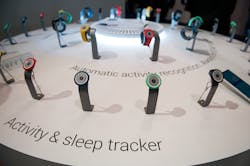From the tangled remains of Google Glass, to the smart watches developed by Apple and Samsung, and the portable health trackers built by Fitbit and Nike—most wearable devices have been designed as miniature versions of existing technology. But the next generation of wearables is expected to include sensors and other components that are uniquely designed to be woven into clothing, pasted onto the skin like a temporary tattoo, or wrapped around body parts like a bandage.
New research from IDTechEx, a technology research firm, predicts that the number of sensors custom-made for wearables will increase sharply over the next decade. In 2026, these parts will represent about 42% of all sensors used in wearable devices, up from 7% in 2015. According to the firm’s previous research, manufacturers are expected to buy over 3 billion sensors during the next 10 years. But nearly a third of these sensors have not been developed yet.
The changing nature of wearable devices is most evident in healthcare, where advanced sensors are giving rise to new forms of medical treatment and health monitoring. At the end of last month, for instance, engineers from the University of California, Berkeley reported a new kind of wearable sensor that can measure sodium, potassium, glucose, and lactate levels in a person’s sweat. The new sensor could help people monitor medical conditions or alert them when they are dehydrated.
Other companies are working toward sensors that are so thin and pliable that they behave almost like a second skin. Last month, the wearable technology company MC10 released a skin patch developed with L’Oreal to indicate how badly skin is being damaged by sunlight. It contains dyes that change color when exposed to ultraviolent light.
Around the same time, MC10 revealed another skin patch that contains a gyroscope, inertial sensors, and flexible integrated circuits that track the electrical activity of a person's muscles and heart. The patch measures only a tenth of an inch thick and weighs around 0.2 ounces. The company expects it to be confined to medical research.
John Rogers, a material scientist based out the University of Illinois at Urbana-Champaign, founded MC10 several years ago as a commercial outlet for his research into flexible electronics. Instead of using uncommon materials like graphene, he builds sensors out of extremely thin sheets of pliable silicon. Among his research prototypes are sensors that can be wrapped around the human heart, medical sensors that can stretch and contract like human skin, and a dissolvable pressure sensor that can be implanted in the skull to measure brain trauma.
“The goal is really to blur the distinction between man-made electronic systems and biology,” Rogers said in a lecture in 2013. He said that his goal was to design electronics that have the same properties as human skin, making it so that they appear to “melt” into our bodies.
But the healthcare industry is still grappling with regulatory and liability concerns that have prevented these sensors from being used in medical treatments. James Heyward, a technology analyst with IDTechEx, says that manufacturers, doctors, insurance companies, and patients have not yet agreed upon a clear system of liability for wearable sensor data. Heyward says that until then, this would remain a “significant barrier” to widespread use of new medical sensors.
According to Heyward, flexible sensors have the potential not only to add new capabilities to existing devices, but also create entirely new markets. The textile and electronics markets, for instance, have already begun to merge around electronic fabrics, or e-textiles. Heyward says that electroactive polymers, textile electrodes, washable inks, and printed piezoelectric sensors can be paired with circuit boards, batteries, and memory chips to create entire systems within clothing.
Most early products are expected to be confined to personal fitness. Among the earliest e-textiles were the heart-rate sensor strap, the first of which was developed in 2002 by Finland-based Clothing+. Last year, Jabil Circuit bought Clothing+ and developed a reference design for e-textiles that measures not only heart rate but also body mass, heat, light, and motion. Several sportswear companies, like Adidas and Under Armour, are also investigating the technology.
In the meantime, companies and universities are engaged in research into new manufacturing techniques that can produce large amounts of ultra-thin, flexible sensors. So far, the only sensors that have been printed in large numbers are those with simple structures. Disposable blood-glucose sensors, for instance, which are covered in re-agents to induce an electrochemical reaction with glucose, are widely used by diabetics.
In the United States, the Flexible Hybrid Electronics Manufacturing Innovation Institute (FHEMII) is focused on reducing the time it will take for printed and flexible sensors to be used in military, industrial, and consumer devices. Toward the end of August 2015, the Department of Defense and several private companies invested about $171 million in the institute.
About the Author
James Morra
Senior Editor
James Morra is the senior editor for Electronic Design, covering the semiconductor industry and new technology trends, with a focus on power electronics and power management. He also reports on the business behind electrical engineering, including the electronics supply chain. He joined Electronic Design in 2015 and is based in Chicago, Illinois.

